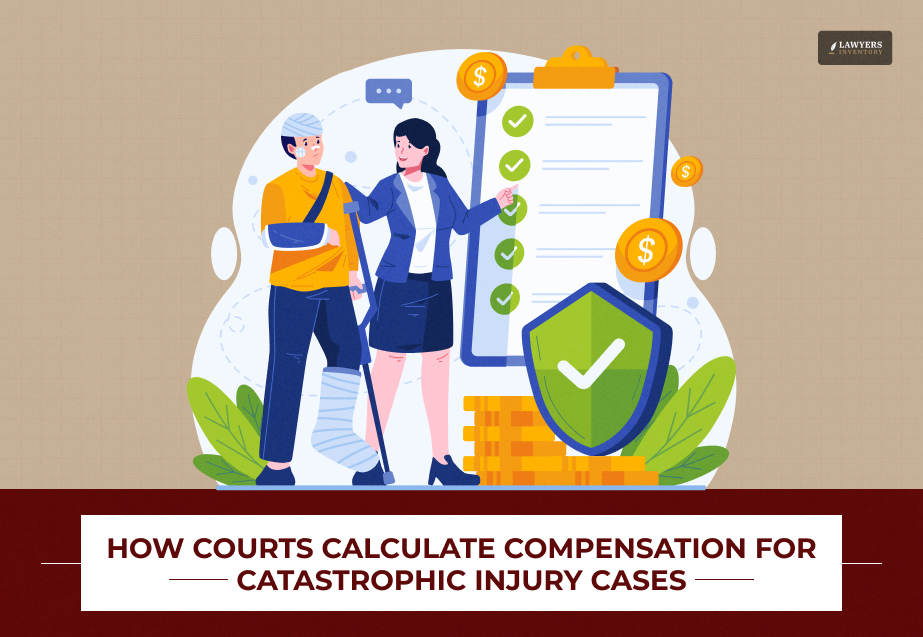
Can you actually file for catastrophic injury compensation? And if so, how much can you claim? If these questions are something that sounds a little familiar, then this article is for you!
Alright, so imagine this—there’s this 32-year-old guy, works construction, ends up with a spinal cord injury on the job. Life just… stops.
He can’t walk, can’t work, and his lawyer now has to convince the court he’s owed nearly $9 million.
And this isn’t just about paying hospital bills. We’re talking about making sure this guy gets the care he needs for possibly 40 more years.
These kinds of cases—catastrophic injury ones—they’re tough. Way more complicated than a sprain or a broken bone. Those heal. But this? This is lifelong.
People need full-time help, special equipment, home changes—the whole nine yards. And figuring out what that costs?
It’s not guesswork. It’s detailed, math-heavy, and the difference between living okay and struggling every single day.
Hi. In today’s blog, I will be talking about how courts decide on catastrophic injury compensation. So, if that’s what you want to know, you have come to the right place.
Therefore, keep on reading this blog till the end and thank me later…
What Makes an Injury Catastrophic?
So, before starting with the entire concept of “catastrophic injury compensation,” let me explain what’s considered “catastrophic,” legally speaking?
Basically, it’s any injury that permanently messes with your body or life—paralysis, brain damage, bad burns, missing limbs. It’s the kind of thing that changes everything.
The key difference here is time. A regular injury? It’s got an endpoint. You recover. But this stuff sticks around for life.
That’s why these cases are so tricky. You’re not just talking about what happened already. You’ve gotta plan for decades down the line.
Life Care Planning
Everything starts with something called a “life care plan.” Sounds fancy, but really, it’s just a giant list of what someone’s going to need from now until… well, the end of their life. Doctors, nurses, physical therapy, wheelchairs, ramps, caregivers—it’s all in there.
Usually, a nurse with special training builds the plan, working closely with medical pros. For someone paralyzed, it might include the following things:
- Weekly check-ups.
- Therapy sessions.
- Home remodels to fit a wheelchair.
- Special vans to get around.
- Someone to help with the day-to-day stuff.
And they don’t just stop at what’s needed now. They’ve gotta predict the future too.
These injuries tend to cause other issues—skin infections, breathing problems, and a bunch of unexpected stuff years down the road. It’s like trying to write a medical to-do list for the rest of your life.
Future Care
After that list is done, economists jump in. Their job is to figure out, “Okay, how much money would cover all this if we gave it today?”
But future money isn’t today’s money—so now we’re talking about inflation, interest, investments… it gets messy fast.
Here’s the thing: medical costs rise way faster than normal stuff. Groceries might go up 2-3% a year, but healthcare? It can jump 5%, sometimes more. So if care costs $50k a year now, it could hit $200k a year in a few decades.
But courts also assume the money will be invested, so they “discount” the future value. Meaning, they estimate how much the settlement will grow over time.
This part’s always a fight—just tweaking the rate a tiny bit can change the final number by millions.
Life Expectancy
And then there’s how long the person’s expected to live. Yeah… that one’s a big deal too.
You can’t just use regular life expectancy charts. These injuries usually shorten lifespan, but not always as much as people think.
Back in the day, a spinal cord injury at age 25 might’ve meant 15-20 fewer years. But now? With better care, many people live pretty long lives.
Defense lawyers will argue, “Hey, he won’t live that long,” because it lowers the payout. The injured person’s lawyer says, “Look, with good care, there’s no reason they can’t live another 40 years.”
It turns into this big back-and-forth because it affects everything—how much care is needed, how long caregivers will be paid, and so on.
Quality of Life and Non-Economic Damages
Okay, now we get into the harder-to-measure stuff—pain, suffering, the loss of doing the things you loved. You can’t put a price tag on that easily, but it’s part of the deal.
Courts will look at the person’s life before the injury—were they active, did they have kids, hobbies, plans?
If someone was an athlete and now they can’t walk, that’s going to hit different than if they were working from home already. But both still lost a lot.
Lawyers sometimes use these “day-in-the-life” videos to show what their routine looks like now, and honestly, that can hit a jury right in the gut.
Breaking Down a Million-Dollar Settlement: How Courts Calculate A Catastrophic Injury Compensation?
Let’s say someone’s 30, and now they’re dealing with paraplegia. A settlement might break down like this:
- First hospital stays + rehab: around $800K
- Lifetime care, wheelchairs, etc.: about $2.1 million
- Home changes: maybe $300K
- Caregivers for the long haul: around $3.2 million
- Lost job earnings: $1.8 million
- Pain + emotional damage: roughly $1.5 million
Altogether, that’s about $9.7 million. It sounds like a huge number—because it is—but it’s carefully built on real projections that stretch out 40+ years.
California’s Legal Environment
If this happens in California, things are a little different—in a good way for victims. There’s no cap on what you can get for economic losses.
So if your care’s gonna cost $10 million, the court won’t stop you from getting that full amount. Plus, living here ain’t cheap. So settlements naturally go higher since care and services are more expensive.
Recursos para Víctimas de Lesiones Catastróficas en California (For Spanish-Speaking Victims)
Las lesiones catastróficas pueden cambiar la vida para siempre, pero usted tiene derecho a una compensación completa por todos los costos médicos futuros, cuidados de por vida, y pérdida de ingresos.
Un abogado de lesiónes catastróficas en California puede ayudarle a entender estos cálculos complejos y asegurar que reciba la compensación total que merece para cubrir décadas de cuidado médico especializado.
No acepte ninguna oferta sin antes hablar con un experto que entienda la parte médica y financiera. Su futuro depende de eso.
The Stakes of Getting It Right In Catastrophic Injury Compensation
Here’s the part a lot of people don’t realize—these settlements? You only get one shot. There’s no going back in 10 years and asking for more if the money runs out.
So if the math’s even a little off—say, 10% too low—you could end up stuck later when medical needs pile up and the funds aren’t there.
That’s why these cases need lawyers who know this inside and out. They bring in planners, doctors, money experts—everyone.
It’s not cheap to build a case like this, but it’s worth it. Because honestly, the difference between a solid case and a weak one? It could mean millions. Literally.
If you or someone in your life is going through something like this, knowing how these numbers work makes it all a little less overwhelming. It also shows why hiring the right help matters.
At the end of the day, this isn’t just about money. It’s about making sure someone can keep living with dignity, even after life’s taken a really hard turn.
Read Also:
- What to Expect in an Insulin Overpricing Lawsuit
- Top Factors Influencing Workers’ Compensation in Georgia
- Dealing With Long-Term Injuries After an Accident: Legal and Financial Options










0 Reply
No comments yet.